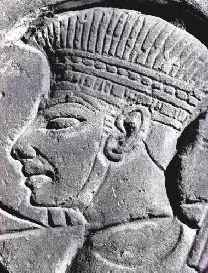|
Other Archaeological Sites / The Neolithic of the Levant (500 Page Book Online)
Egypt, Canaan, and Israel in Ancient Times
Winner of the 1993 Best Scholarly Book in Archaeology PART THREE: The Great Migrations
CHAPTER 9: The Coming of the Sea Peoples
Excerpts and Definitions and Addendums:
EGYPT AND THE AEGEAN During the New Kingdom Greece and the islands had enjoyed consistently good relations with Egypt even though for popular consumption the Egyptians had passed off trading overtures from the Aegean as the proffer of tribute. By about 1520 B.C. the language of "Keftiu" (Canaanite Kaphtor) was sufficiently familiar to the Egyptians that spells could be trancribed into .hieroglyphics (2). Under Thutmose III the procession of Aegean benevolence bearers in their colorful costumes (recalling Aegean frescoes) became familiar in Memphis and Thebes; and under Amenophis III the sea routes around the Aegean were so familiar to Egyptian sailors that the "periplus" could be rendered into Egyptian so that the towns like Knossos -- Amnissos -- Pylos and others appear in hieroglyphic script ...
There is no reason to doubt that the Egyptian court was at all times during the Mycenean Age in correspondence with the court at Mycenae -- although the letters have not as yet been recovered. Pharaoh corresponded with the King of Alashiya (Cyprus) -- as the Amarna letters show -- and Cyprus was an entrepot in the trade with Greece ..... But Egypt also had experience of Aegeans less welcome than emissaries and tribute bearers. The small communities in the islands and on the Ionian coast, hemmed in by the rugged terrain, had long subsisted on limited agriculture -- fishing -- sea raiding; and this latter activity had long since been directed toward the rich cities of the Levant and the Egyptian coast. The Lukka -- in whom we should see the Lycians -- and the Shardana from the Ionan coast near Cyme had a name for piracy and exceptional fighting skill(6). The latter at the beginning of the reign of Ramesses II had attacked the Delta coast thus bringing themselves within Pharaoh's purview; and the young Ramesses was not tardy in appreciating their military prowess. Having frustrated their attack the king lost no time in recruiting a contingent of Shardana into the Egyptian armed forces; and they were to distinguish themselves shortly at the Battle of Kadesh "THE NORTHERNERS ARE RESTLESS ..."
The ultimate causes of the movement are difficult to assess but certain suspicious occurrences and conditions seem to have prevailed in concert. On the economic side it has been maintained that the Mycenean states suffered an inherent weakness in being dependent on a single high-yield crop and having to import many raw materials. The age-old practice of piracy and the recent success of the Shardana may have tempted peoples within the penumbra of the Mycenean world to strike at the sources of the raw material. Others opt for natural disaster as the primary factor in setting the Sea Peoples in motion. Although it cannot be proved that widespread famine and crop failure in the last third of the thirteenth century disrupted life on the north shore of the eastern Mediterranean, three or four sources of evidence -- eight centuries removed from each other -- seem to corroborate such a hypothesis. Diodorus and Herodotus preserve the memory of a famine that forced peoples from Syme -- Naxos -- Sardis to emigrate; and indeed contemporary documents from Egypt and Ugarit speak of famine in Anatolia. It is easy to understand how the superabundance of food stocks in the Nile Valley would have proved an irresistible attraction to the hungry enclaves in the Aegean. That bubonic plague or a similar epidemic played a role is possible but impossible to verify at this distance in time (8) Did political trends assist in the collapse? Are we clear-sited in discerning an incipient breakdown in the system of Late Bronze Age superpowers -- the "great kingships"? If this was indeed taking place it might have led to the fragmentation of the former empires and the consequent intestine strife among the erstwhile vassals. In this connection it should noted that the Hittite King Tudkhaliyas IV -- sometime between 1250 and 1240 B.C. -- was faced by a confederacy of twenty-two rebellious states along the Ionian coast from Caria in Lycia to Troy. The Hittites defeated this coalition but the western periphery of their empire begun to break up. It was apparently this same Tudkhaliyas who conquered the island of Cyprus -- thus terminating another of the prominent and prosperous exponents of the Late Bronze Age political system ...
THE FIRST MOVE ON EGYPT The net effect of the weakening of Akhkhiyawa and the turmoil of Tudkhaliya's reign was to liberate those lesser states in the islands and along the western coast of Asia Minor that lay between the former empires. The international treaties between the great powers did not bind them and the rich states of the east were "fair game". Their fighting qualities and in particular their superior weaponry gave them a confidence the Levantine states lacked. For the Aegean and the Ionian coast had fallen heir to the great metallurgucal advances attested in the Balkans during the fourteenth and thirteenth centuries; advances that manifested themselves in the long swords -- shields -- helmets -- body armor of sundry members of the Sea Peoples ... If as we know it did Egypt acted on the northerners like a great magnet, two possible routes lay open to those who wished to attack Egypt from across the Mediterranean. The most obvious lay along the coast of the eastern Mediterranean with Cyprus as an intermediate halting point. A less obvious but well-traveled route would take the voyager via Crete due south to the north African coast with a landfall in the neighborhood of modern Mersa Matrukh. Here recent excavations have revealed an entrepot serving trade between Crete -- Cyprus -- Delta in the fourteenth century B.C.; perhaps giving access to the inland route into Africa by way of the western oases. In any event by the last quarter of the thirteenth century B.C. the coast west of the Egyptian Delta was familiar to seamen and caravaneer alike and provided a direct access to Cyrenaica, which had the ability to be carefully guarded; for in those days this vast region supported a sizable and bellicose population ..... The aged Ramesses II had passed away in about 1237 B.C. after a reign of sixty-seven years and had been succeeded by his thirteenth son (in order of birth) -- Ramesses II having outlived the first dozen of his many sons. Merenptah was already an aged and decrepit man when he came to the throne and although he had earlier been trained as a soldier his active carrer in the army was long past. In his second year he traveled down to Thebes from his capital in the Delta "to see his father Amun -- King of the Gods" and to authorize an inventory of temple treasures; but while this peaceful activity was in progress an enemy force was on the move ... From the dawn of Egyptian history Libyan tribesmen had always been a thorn in the side of the pharonic government -- but their small numbers had prevented them from posing any serious threat to Egypt. During the New Kingdom however these older tribal groups had been replaced or absorbed by newcomers from the west: the Labu (who eventually gave their name to "Libya") -- the Meshwesh -- the Asbuta -- the Hasa and others (9). With long cutaway gowns -- bearded and wearing their hair in a long curl on one side -- the Labu and Meshwesh had long sinced graced Ramesside triumph scenes as the enemy whose defeat is to be celebrated. But if under the great Ramesses they had been easy prey for Pharaoh's forces, under Merenptah they proved much more formidable. For now they were joined by piratical elements from the Aegean: the sea route to Libya was now a supply route ... In his fourth book Herodotus gives a fairly detailed account of the Libyan tribes of his day and in chapter 191 descibes one called the Maxyes (Meshwesh): "West of Triton ... Libya is inhabited by tribes who live in ordinary houses and practice agriculture. First come the Maxyes, a people who grow their hair on the right side of their head and shave it off on the left. They stain their bodies red and claim to be descended from men of Troy". In a similar vein Pindar (Pythian 5.81-83) preserves a tradition that sons of Antenor migrated to Cyrenaica from Troy. Another legend had it that, in the generation preceding the Trojan War, a certain Mopsus (or Moxos), serving as seer with the Argonauts, died of a snake bite on the North African coast and was buried at Cyrene. All these traditions attest to the survival in folk memory of a historic fact: at the time of the breakup of the Akhkhiyawan Kingdom -- and the expedition against Troy -- the route to the Libyan coast was well traveled by Aegean freebooters. The inscriptions of Merenptah record the facts of which the traditions are a dim memory ... To judge from Merenptah's account the capital was apprised of the Libyan invasion only at the beginning of April in Merenptah's fifth year. By that time the horde -- with the Labu taking the lead numerically and politically -- had swept over the northernmost of the string of western oases and had entered the Delta. Encouraged by Ptah in a dream, the king mustered his forces and decided to attack the invaders in early May. The enemy he faced represented a coaltion consciously conceived and put together by the chief of the Labu -- Mereye. Besides the Meshwesh who tagged along with their cogeners, Mereye had enlisted the help of the people of the island Kos (10) and the Lycians. These in turn had persuaded smaller groups of Shardana -- Tyrsenoi -- and Shekelesh to accompany them. For six hours the opposing armies hammered each other at Par-Yeru near Buto in the northwest Delta until the invaders cracked and fled. Unlike the patently smaller engagements of the time of Thutmose III or Amenophis II -- the route turned into a slaughter: while the Egyptian sources conceal their own losses, over nine thousand of the enemy were killed ..... But the Libyans were not to be denied. In the twenty-five years of weak government by the regimes of four short-lived kings who followed Merenptah the Labu and the Meshwesh entered the western Delta uninhindered and settled as far east as the bank of the central Nile -- destroying the towns of the Xoite township. The unfortunate Siptah -- who suffered not only from the effects of polio but also from the machinations of his sister Tawosret and his Canaanite chancellor Bay -- was powerless to stop them. It was left to the family of the victor in a palace revolution -- one Sethnakht -- to deal with problem: and in Ramesses III, the latter's son, Egypt had at last found a competent avenger ..... The initial outbreak of hostilities centered upon the dynastic succession among the Labu. Ramesses III apparently refused to release one of the chief's children -- whom he had taken captive -- to succeed his father; and pursuant thereto the Libyans crossed the frontier and attacked. As before the Labu were accompanied by auxiliaries: from Libya itself the Meshwesh -- Asbutae -- and Hasa; from the Aegean, again a contingent from the southwest corner of Asia Minor, this time the Karkisa, as well as another contingent from Samos and Abdera. This time the victory was more complete than under Merenptah: See! I (Ramesses III) destroyed them and slew them at one stroke. I overthrew them, felled them in their own blood, and turned them into heaps of corpses. I turned them back from treading the frontier of Egypt ... I brought the rest ... as numerous prisoners, pinioned like fowl before my horses, and their wives and children by tens of thousands ... The Libyan menace was thus at an end. Although on another occasion -- six years hence -- the Meshwesh would mount an invasion on their own, their effort would prove feeble. But a minor detail in the records of Ramesses III in his great mortuary temple at Thebes is a harbinger of things to come: two of the captive chiefs bear quite un-Libyan types of names -- Melie and Moschion -- each determined by a kneeling captive with a floppy plumed headdress (11) Egypt was soon to see a veritable ocean of such plumes ... THE INVASION OF YEAR EIGHT Previous encounters with the Aegean pirates had accustomed Egypt to look for hardy warriors in a few "long ships" bent on a speedy raid to be followed by as speedy a retirement. (Such raids are commemorated in the Odyssey 14.246ff which may well be a faint memory of the expeditions under Ramesses II or Merenptah). Even the Levant from time to time had been visited by individuals from the Ionian coast or the Cyclades. What neither Egypt nor Palestine had experienced heretofore however was an outright invasion of peoples from the Aegean, intent on settling down. While trade with Greece and the islands had flourished as we have seen during the Late Bronze Age, there is not a particle of evidence to support the contention that prior to year 8 of Ramesses III, early waves of Sea Peoples had already settled on the coastal plain of Palestine. The invasion of year 8 was sudden and unique; and all references to "Philistines" in the Bible must postdate it ... One is accustomed to think of the coalition of the seven groups that constituted the horde as taking shape suddenly and the invasion as following quickly. In fact year 8 simply marks the record of their defeat at the hands of the Egyptians; the founding of the confederacy may well date several years later (12). Until recently the only record still preserved of this incursion of peoples into the Near East was that of Ramesses III himself, preserved on the walls of his mortuary temple Medinet Habu at Thebes; and in spite of the exciting finds at Ugarit this remains the sole contemporary account ...
In the great invasion of year 8 then we appear to be dealing with a coalition of peoples that encompassed the Ionian and Pisidian coasts -- centering especially on Caria -- and which may have involved mainland Greeks. The nautical record bears this out: the ships of the Sea Peoples -- as depicted at Medinet Habu -- are very much in the Aegean (rather then Crete) tradition. Can anything else be said ... The period of the onslaught of the Sea Peoples -- the close of the thirteenth century B.C. -- is the inception of the Iron Age. It is the earliest period that lies within the compass of the dim historical memory of the later Greeks -- in the historical legends of the sixth to fourth centuries B.C. Despite the passage of time the tendency to personalize impersonal events and the inevitable distortion or anachronism the legends are most illuminating. Mopsus of Colophon, for example, said to have been the offspring of fugitives from Boeotia, in the years immediately following the Trojan War led the peoples from the Ionian coast across the Taurus Mountains and into Pamphylia and Cilicia; whence some migrated further afield into Syria and Palestine. Likewise Amphilochus is also connected with a movement from the Aegean to Pamphylia after the Trojan War and became the reputed founder of Poseidon in Syria. Similarly Teuker, brother of Ajax, who had fought in the Trojan War, led migrations that ended up in Cyprus and Cilicia; and Agapenor too, King of the Arcadians, is supposed to have come to Cyprus after the Trojan War. If these legends, the salient exemplars of a numerous array of similar tales, take the migration as far as Syria, founding legends linked to the later Philistine cities carry the account one step further by linking Ashkelon with migrations from Lydia and Gaza with refugees from Crete (17)
The end was near. In truth no one could stand before these raiders. Hattusas was destroyed and the Hittite Empire swept away in one stroke. Tarsus was laid waste as was Enkomi on Cyprus. Alalakh and Ugarit were razed to the ground -- never to be rebuilt. The Late Bronze Age of the Levant vanished in an instant: archaeology gives a graphic dimension to the terror conveyed by the written record ... From their camp in Amurru -- that is in the Eleutheros Valley -- the confederacy trundled south, women and children in oxcarts, while the ships kept pace off the coast. It is one of the ironic gaps in our records that nowhere has the precise location of the final battle (or battles) been conveyed to us. But in the reliefs Ramesses does (perhaps unwittingly) indicate that it was not in or even on the border of the Egyptian Delta. Pharaoh knew they were coming and to that end he established a fortified line in Asia: I prepared my frontier in Dijay and fortified it against them with chiefs -- garrison commanders -- maryannu. I had the Nile mouths fortified like a strong wall with a fleet of warships -- cargo vessels -- boats ... manned completely from stem to stem with brave soldiers with their weapons and infantry; all the choicest warriors of Egypt. To take command of the counterattack His Majesty departed for Dijay. Dijay is too vague and archaic a term to help us in this regard; but a tradition that apparently derives from Xanthos (Fifth Century B.C.) places a Lydian army in the vicinity of Ashkelon in the period this chapter treats of (20). And it may well be that the movement was only stopped on the southern coastal plain .....
|

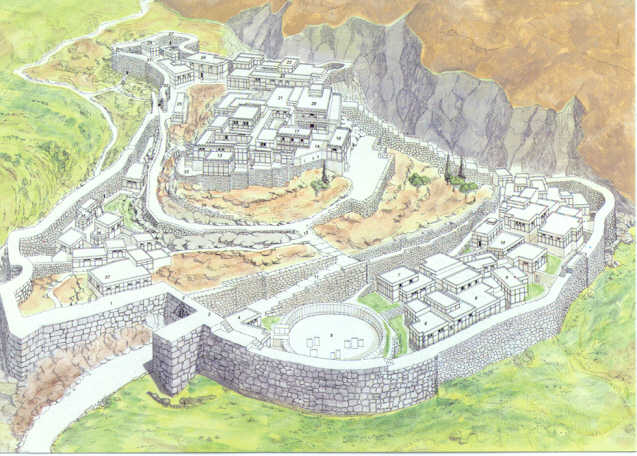
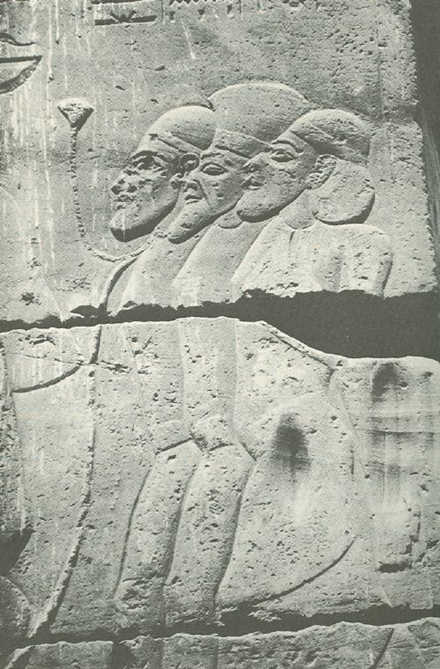
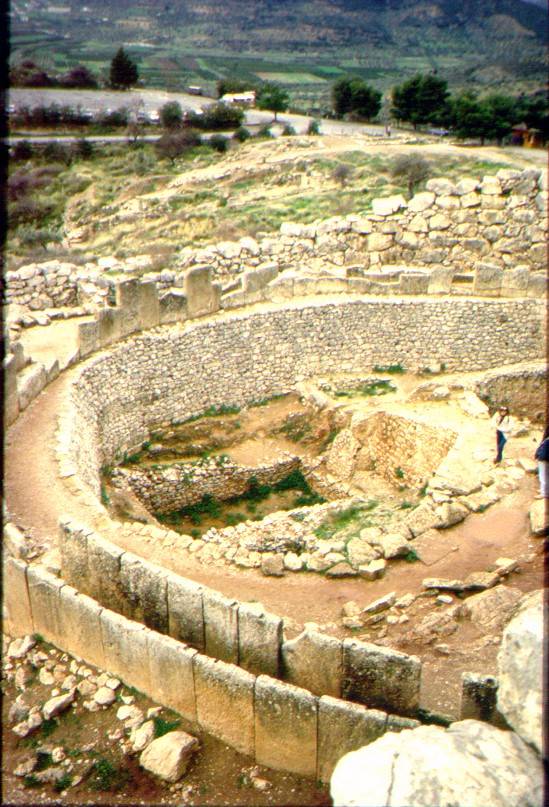
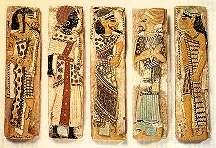 The foreign lands made a convocation in their islands, bursting forth and scattering in the strife of the lands at one time; no land could stand before their arms, beginning with Khatte, then Qode, Carchemish, Arzawa and Alashiya (Cyprus) -- all cut off at one stroke. A camp was established at one spot within
The foreign lands made a convocation in their islands, bursting forth and scattering in the strife of the lands at one time; no land could stand before their arms, beginning with Khatte, then Qode, Carchemish, Arzawa and Alashiya (Cyprus) -- all cut off at one stroke. A camp was established at one spot within 